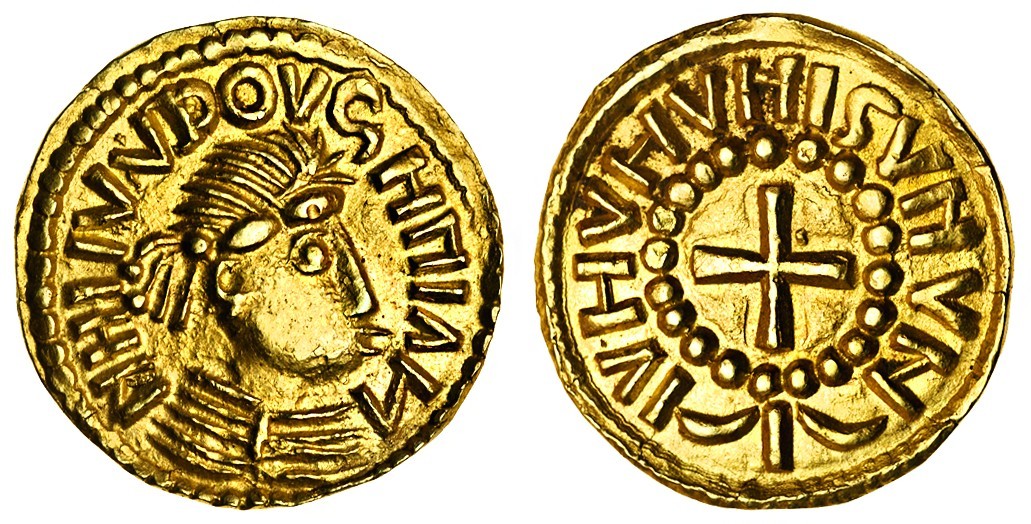
Auction: 14007 - Ancient, British and Foreign Coins and Commemorative Medals
Lot: 484
Anglo-Frisian, Solidus, 4.38g, c. imitating a Solidus, c.816, of Louis the Pious (814-840), naive style laureate and draped bust right, the laurel formed of two thick-set oblong bars and the crude drapery divided centrally, NHIIVVDOVSHNIAN, the final N reverse-barred, this legend based on the prototype DN LVDOVICVS IMP AVG, rev. cross pattée within suspended laurel wreath, IVHVHVNISVNVN, based on prototype legend MVNVS DIVINVM (Grierson Group XV/XVI derived, no die duplicates evident; Prou.-), obverse fractionally off-centre and with unusual circular punch mark upon front portion of laurel, otherwise as struck, of exceptional quality and artistic appeal, a remarkably well preserved field find with some remnants of earth left in situ; this a landmark discovery for the numismatic market
provenance
Found West Lindsey district, Lincolnshire, 7 August 2014
Recorded with the Portable Antiquities Scheme, British Museum,
ref. LANCUM-9E265D
With this most recent discovery the number of Louis the Pious imitation solidi found in Britain now stands at 13 examples with 9 examples (including the current piece) being found in England. A corpus of these English found imitations is listed in Spink auction 199, 25 June 2009, p.87. It was in this auction that the last English found solidi was sold having been discovered in March 2009 near Salisbury. Therefore, it has been 5 years since a specimen was unearthed in English soil. Notably the gold content of the current piece appears high and the weight at 4.38g complies with the established weight standard of c. 4.4g for solidi of the period. This would, therefore, point towards an earlier imitation which was struck for trade purposes. Further evidence that solidi circulated for trade in ninth century Lincolnshire is the discovery in November 1996 near Louth of a cut quarter Pious solidus, possibly of Aix-la-Chapelle, cf Spink auction 126, 14 July 1998, lot 270. Lincolnshire, situated directly east of Frisia (the place of mintage for most known imitation solidi) across the North Sea, is also the find spot of the remarkable imitative solidi lead trial piece. This unique artefact, found at Torksey (also West Lindsey district) lends good weight to the argument that imitative solidi were struck in Britain during the ninth century. The four coins comprising Grierson's Type XVI, three of which are die duplicates, are a case in point. The cataloguer quotes; 'Two were certainly found in England, one at Cambridge and the other at Lewes; the other two were acquired by the British Museum from private persons, not collectors, and were almost certainly found in this country. I am disposed to regard the isolated specimen as an importation from Frisia sometime in the mid-ninth century, and to suppose that the others were struck in imitation of it.'. Out of all Grierson's types both XV and XVI appear to be most closely related in style, epigraphy, and legend to the current piece. Grierson himself acknowledges that both the aforementioned types are related and the cataloguer believes the current piece to form part of this larger series. It is interesting to note that at this stage in the series of 'imitations of imitations' the naive style appears to have an affinity towards the Saxon style whilst remaining true to the Roman inspired Carolingian prototype. A remarkable work of art from 9th century England with mounting evidence toward the piece being struck in the same.
Subject to 20% VAT on Buyer’s Premium. For more information please view Terms and Conditions for Buyers.
Sold for
£36,000




